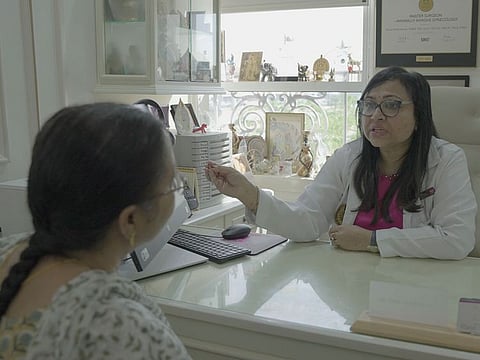3kg tumour: UAE doctors discover extreme pain caused by unusually large fibroid from 50-year-old woman, removed via combo surgery
Special combination of surgical procedures performed at Dubai hospital

Dubai: Three kilograms of multiple large fibroids were found and removed from both the uterus and liver of a 50-year-old woman, thanks to an unusual combination of surgical procedures performed by a team of doctors in the UAE.
As far as fibroids go, it’s an abnormally large size. How the fibroids developed in the two organs is also quite puzzling.
The discovery led doctors to perform surgery, but it’s not just another surgery. Rather, it was a combination of procedures. This helped the patient, an Indian expat, got her normal and quality of life back.
Extreme uterine fibroids
Doctors at Medcare Women and Children Hospital in Dubai described the condition of the patient, identified as Jayanthy, as “extreme uterine fibroids”.
It caused her unbearable pain, and, if left untreated, could have become life threatening. Fibroids are tumours made of smooth muscle cells and fibrous connective tissue that develop in the uterus. It is estimated that 70 to 80 percent of women will develop fibroids in their lifetime — however, not everyone will develop symptoms or require treatment.
Symptoms
Jayanthy faced a combination of serious symptoms like pain, tiredness and dizziness caused by secondary anaemia due to heavy bleeding.
Upon visiting Dr. Shiva Harikrishnan, obstetrics and gynaecology consultant at Medcare Dubai, a workup has been conducted.
An unexpected discovery was made.
Dr. Harikrishnan said, “The patient had initially come in due to her gynaecological issues. She was presenting an abdominal size approximately equivalent to an eight-month pregnancy. When we did the scan, we finally saw the extent of how big the fibroids were and realised that they needed to be removed.”
What are uterine fibroids?
Uterine fibroids are benign tumours that grow in the uterus and are common among women of reproductive age.
“Although extremely common, especially amongst women in their 40s and 50s, fibroids are often not discussed due to the lack of attention and information. Even though fibroids are non-cancerous, they can have severe effects on women and are one of the leading causes of hysterectomies (removal of the womb),” said the doctor.
Multiple large fibroids
Following multiple scans, Dr. Harikrishnan discovered that the patient had multiple large fibroids in her uterus which required a rare combination of surgical methods — laparoscopy and mini-laparotomy.
“Although surgical removal of huge fibroid may be challenging, this one was quite unique. We decided to go as first option by laparoscopy.”
But due to the lack of space and size of fibroids, doctors proceeded with a mini-laparotomy — a surgical incision into the abdominal cavity — of 4-5cm in the tummy to remove the fibroids.
Dr. Harikrishnan and a general surgeon colleague began removing the fibroids in the patient’s body using a mini-laparotomy incision. That’s how the multiple large fibroids were removed, with the largest covered an area of 20 by 20 centimetres.
Another surprise discovery
However, before the surgery could be completed, her doctors discovered that the patient was carrying another large fibroid near her liver.
Dr. Harikrishnan said: “The discovery of the fibroid near the liver prompted me to stop the mini-laparotomy and close up the abdomen and again inflate the abdomen with gas to do a laparoscopy again.”
WHY GAS IS USED IN LAPAROSCOPY
Carbon dioxide (CO2) is the most commonly used gas for “insufflation” during laparoscopic surgery because it is colorless, inexpensive, nonflammable, and has higher blood solubility than air, which reduces the risk of complications if venous embolism occurs. Nitrous oxide pneumoperitoneum is also used during laparoscopic abdominal surgery, and appears to decrease post-operative pain in patients with low anaesthetic risk. Another type of gas is helium pneumoperitoneum; one of its benefits is that it decreases the cardiopulmonary changes associated with laparoscopic abdominal surgery.
Combination surgery
The other option to remove the fibroid near the liver, needed a large vertical cut — about 15-20 cm — in the abdomen, which would have led to a delayed recovery for the patient.
“Therefore, we opted to perform a combination of two surgical approaches (laparoscopy and mini laparotomy), to remove all the fibroids including the fibroid near the liver,” she said.
The surgery was successfully completed. Post-surgery, the period was largely uneventful for the patient who was on her way to making a full recovery.
Living normally again
Commenting on the experience, Ms. Jayanthy said, “I am thankful for Dr. Harikrishnan’s expertise and compassion, which has helped me finally overcome this illness.
“After being in pain for a long time, I am glad to say that I can now live my life normally again without any discomfort.”
Dr. Harikrishnan further stated, “Cases such as this highlight the importance of women’s healthcare. Women have unique health needs that require specialised attention, and neglecting these needs can lead to long-term health consequences including preventable deaths, disabilities, and reduced quality of life.
“Routine screenings, preventive care, and early detection of health issues are crucial in ensuring that women receive the care they need and deserve.”
Jayanthy has made a complete recovery since her operation and is currently back to her normal life.
Sign up for the Daily Briefing
Get the latest news and updates straight to your inbox


